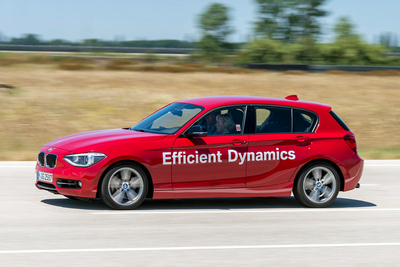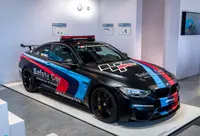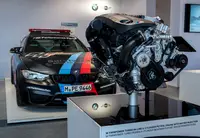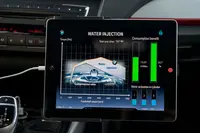Driving The BMW 1 Series Prototype With Direct Water Injection Review +VIDEO
 BMW 1 Series Prototype with Direct Water Injection |
By Henny Hemmes
Senior European Editor
MIRAMAS, France - July 22, 2015: - Earlier this month, The Auto Channel already reported on one of the technologies that BMW wanted to share with us during their recent Innovation Day at the Miramas test facility in southern France. It was the plug-in hybrid driveline (LINK), which will - from now on - be implemented in new or renewed models. The PHEV-system debuted in the X5 xDrive 40e. The next model line is the 3 Series, that has just been updated and will arrive on markets worldwide this month (LINK).The 330e is the PHEV-model, but it will not arrive on the markets before mid 2016.
 BMW M4 MotoGP Safety Car |
Apart from plug-in hybrid and electric vehicles, car manufacturers keep on investing time and money to improve the internal combustion engines in order to improve fuel consumption. BMW used its Innovation Day at Miramas to show us their direct water injection technology by means of displays as well as the possibility to drive one of prototypes on the track.
Old technique dug up
Water injection is not entirely new, as it had been used for engines in
military planes in World War II, in order to increase thrust for a short
while, such as on take off or in dog fights. The pilots could push a button
to inject water into the blowers. Later, water injection was used by car
manufacturers like Chrysler and Ford, who squirted water into the
carburetors of their big V8 engines to improve performance. In this
respect, Europeans may recall the Saab 99 Turbo S that also featured water
injection, which has also been used in race cars for many years.
From the track to the road
 |
During last month’s Innovation Days, BMW presented the technology in a 5-door 1 Series prototype, equipped with the new generation 3-cylinder engine. In this case, the water injection system is taken to the next level and is sprayed in tiny drips in the manifold plenum chamber just before combustion. There it evaporates, extracting energy from the surroundings and reducing combustion temperatures in the engine by around 25º Celsius.
Anywhere in the world
The injection of H2O has a cooling effect on the combustion process and
increases power and torque, especially at, or near full throttle. BMW says
that engine power and torque are improved by up to 10 per cent.
Reduced combustion temperatures lead to lower emissions and reduce the risk of uncontrolled combustion (detonation or knock). This allows a higher compression ratio. In the case of the prototype’s 3-cylinder engine it is increased from 9.5:1 to 11.0;1, which optimizes efficiency in the low and medium throttle range. But the car can still run on low octane gasoline (Ron 95), which also means that it can be used in markets worldwide. Because of the lower thermal load and higher efficiency, fuel consumption as well as emissions can be reduced to up to 8 percent under normal driving circumstances.
Self supporting
The direct water injection system in the prototype is destined for
future production models and never requires refilling in daily use. Only
when the car is driving in exceptional climate conditions, the system is
fully self-replenishing, thanks to on-board water recovery. The water level
is maintained by the continuous recovery of condensed water from the air
conditioning system. When the engine is switched off, all water in the hose
system is drained into the tank. This prevents components from freezing in
temperatures below zero and prevents engine corrosion. The water tank is
connected to the A/C reservoir and located in a frost-protected position in
the car.
Seeing is believing
I got behind the wheel of the red prototype with Werner Mährle, the
responsible engineer, in the passenger seat.
BMW uses the 150/ kW/201 hp strong 1.5-liter 3-cylinder turbo engine that is used in the BMW 2 Series Active Tourer and the Mini Cooper. With water injection it produces 160 kW/215 hp with 236 pond-feet of torque.
While I start to lap the Miramas track, Mr. Mährle says that a mixture of 3 per cent H2O is needed for the optimal combustion: “The output can be increased by 5 to 10 percent and the fuel consumption can be reduced by 3 to 8 per cent.” He also said that 80 per cent of the customers are driving some 12 thousand miles per year and will never have to top off the H2O level of the tank that can have a content of 1.3 to 1. gallons. The other 20 per cent of drivers, are people who hardly use the A/C, or drive on race tracks.
 |
At the test track I lapped with different speeds and different acceleration between 50 and 80 mph. The engine runs very nicely, is flexible and fast reacting to heavy throttle input. The monitor that has been installed in the car shows when the water is injected – during acceleration and not during cruising - and after my run that the car used 1.06 l/100 km less fuel than without water injection, which is an advantage of 15.7 per cent. The outside temperature was 95 degrees fahrenheit and our air conditioning was working hard, accumulating 2 liters of water per hour, more than enough to keep up with the consumption of 0.2 liters during my stint. But if the water level is getting too low, there will be a warning in the instrument panel. Then, it is easy to add some distilled water to the tank that is situated centrally under the hood.
BMW does not share any plans for bringing this technology in a production model, but I guess it can be implemented in one of the new upcoming turbo charged models pretty soon.


